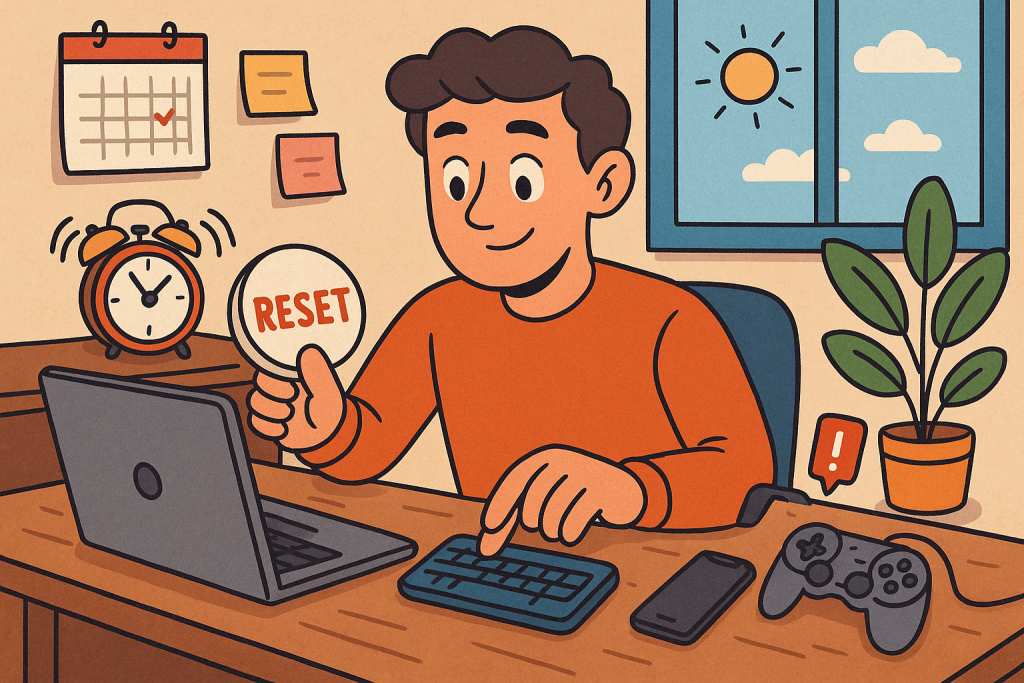After a week filled with constant pings, endless social feeds, and a sense that time slipped away—this guide explains how to reset after a week of distractions using proven, trending tactics like digital detoxes, dopamine breaks, and purposeful silent walks. You’ll leave feeling recharged, clear-headed, and in control again.

Why Resetting Matters
When distractions pile up, they don’t just interrupt tasks—they cloud your brain. Tech experts have coined this condition “brain rot”—where your memory, attention, and critical thinking suffer from trivial digital noise. A deliberate reset helps you recover mental clarity, better sleep, and reduced screen fatigue.
Resetting isn’t a luxury—it’s essential. Emerging studies show even short digital detoxes boost mood, productivity, and relationships. Ready to reclaim your week? Here’s how.
Step 1: Hit the “Dopamine Reset” Button Today
The Trend: Dopamine Detox
2025’s self-care buzzword is the dopamine detox—swapping screen addiction for mindful moments. It’s not about deprivation—it’s about restoring equilibrium.
How to do it:
- Pick a 2-hour period (even on a weekend).
- Turn off notifications.
- Switch your devices to grayscale—or stash them in another room.
- Replace the scroll with reading, cooking, or walking.
Why it works:
- Reduces overstimulation from endless pings and feeds.
- Frees up mental space for creative or reflective tasks.
- Starts rebalancing your reward system.
Step 2: Take a Digital Detox Day
Longer breaks are trending, including nature-based “digital detox vacations” where Wi-Fi is intentionally absent. Even at home, a day offline can reset your attention.
How to structure it:
- Announce your intent: let friends/family know you’ll be off-grid.
- Create phone-free zones: bedroom, kitchen, workspace.
- Use analog alternatives: paper planner, printed book.
- Plan non‑digital activities: hike, cook, puzzle, journal.
Research shows a two-week social media detox improves addiction, sleep, stress, and life satisfaction—even if effects recede a bit over time. But even one day—a micro detox—can kickstart long-term change.
Step 3: Add Silent Walking to Your Reset Routine
This healing habit has gone viral on TikTok: silent walking—leaving your earbuds and phone behind to walk mindfully. It calms the nervous system, boosts creativity, and anchors you in the moment.
How to do it:
- Schedule 15–30 minutes daily.
- No tech, no distractions—just footsteps and breathing.
- Notice surroundings: wind, sounds, physical sensations.
- Try brisk walking to combine movement and mindfulness.
Over time, it develops baseline calm and mental resilience.
Step 4: Break the Work-Distraction Cycle with Pomodoro & Clean Desk
Even after detox moments, distractions can creep back. Two effective habits:
Pomodoro Technique
Work for 25 minutes, then take a 5-minute break—repeat 4×, then a longer break. Helps maintain sharp focus and prevent burnout.
Clean Desk Policy
Clear your workspace at day’s end to mark a boundary between work time and personal time . It gives you closure and prepares you for a fresh start tomorrow.
Step 5: Rebuild Digital Boundaries
After your reset, keep the momentum going:
- Create interaction-free times: e.g., no screens 1 hour before bed—helps better sleep.
- Limit social media: Use blockers (Freedom, OffScreen) or schedule 30-minute windows.
- Notifications audit: Turn off non-essential alerts.
- Designate screen-free zones: maybe the entire bedroom or dining area.
These habits prevent rebounding into scatters of distraction.
Step 6: Support Your Mind—Nature, Sleep, and Hobbies
To ensure lasting recovery, reinforce your brain:
- Spend time in nature. Gen Z are returning to outdoor “nature bathing” as a reset from screen life.
- Prioritize restful sleep. Quality sleep underpins focus and mood.
- Pick up an offline hobby. Reading, drawing, puzzles, exercise—and log at least 30 minutes daily.
These habits not only reset—you’re building a distraction-resistant foundation.
Weekly Ritual: Your Reset Plan
Here’s a streamlined weekly routine to restore clarity:
| Day | Morning | Midday | Evening | Notes |
|---|---|---|---|---|
| Monday–Friday | Silent walk (15–30 min) | Pomodoro blocks, clean desk end-of-day | Tech-free 1 hr before bed | Build focus and healthy screens use |
| Sunday | Digital detox day | Nature outing | No social media | Full mental reboot |
Why This Combo Works
- Dopamine detox + digital detox days break your attention dependency.
- Silent walking develops mindfulness and calm.
- Pomodoro & clean desk support productive routines.
- Nature, sleep, hobbies boost long-term mental resilience.
Research confirms that even moderate resets dramatically improve focus, stress reduction, and mental clarity.
Final Word: Make Resetting a Habit, Not a Once-Off
Resetting after a week of distractions doesn’t have to be exhausting. With purposeful rituals, you can reclaim clarity and energy without drastic overhauls. Integrate these habits gradually—digital detox breaks, mindful walks, productivity rituals—and build a life that thrives in focus, balance, and presence.
References
Stacey Lastoe, “This Is Nuts: It Takes Nearly 30 Minutes to Refocus After You Get Distracted,” The Muse, updated June 19, 2020.
www.themuse.com
Chris Bailey, “4 Strategies for Overcoming Distraction,” Harvard Business Review, August 30, 2018.
hbr.org
Melissa Madeson, Ph.D., “How to Focus Easily in a World of Distractions: 6 Techniques,” PositivePsychology.com, April 2, 2025.
positivepsychology.com






